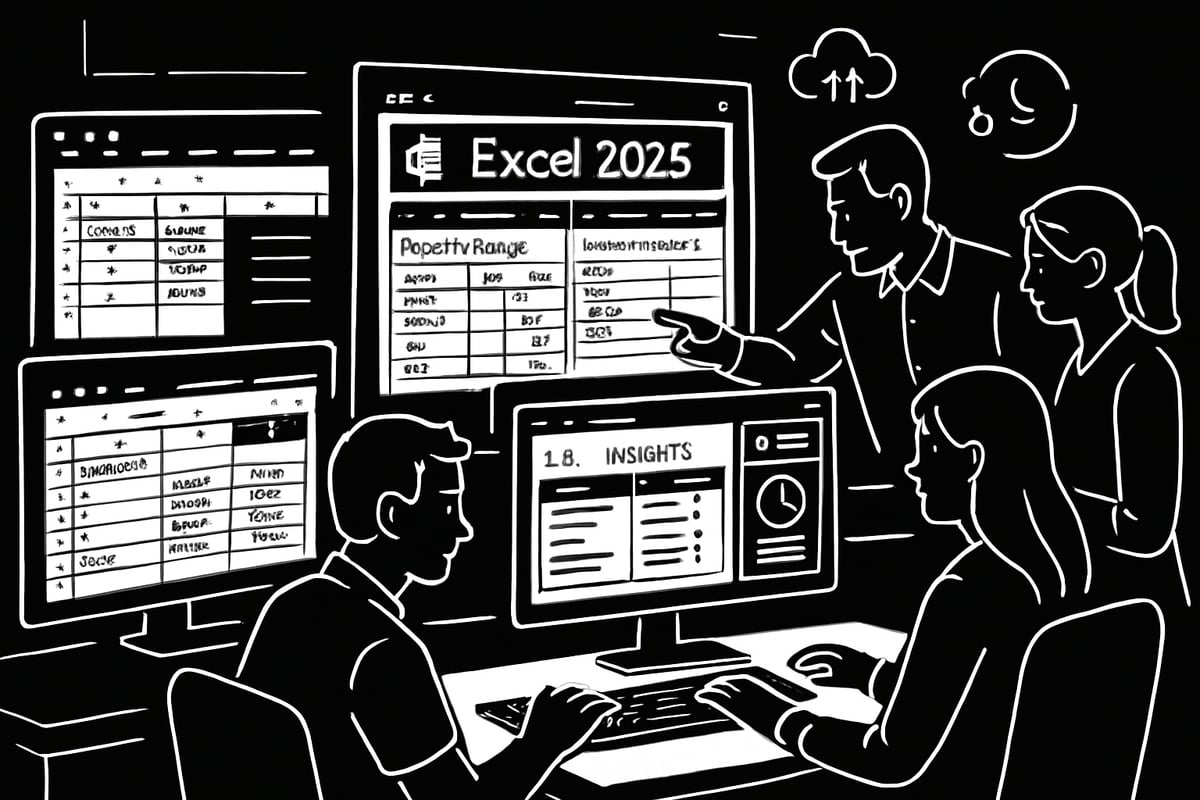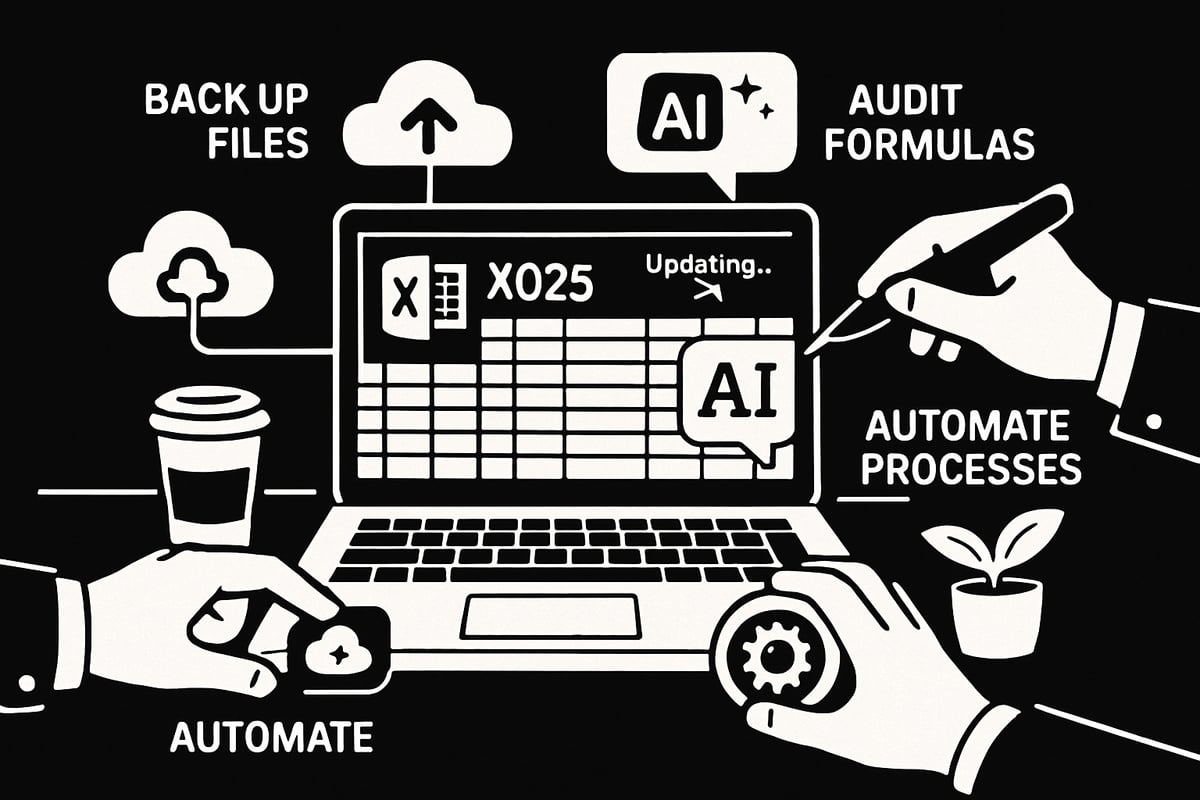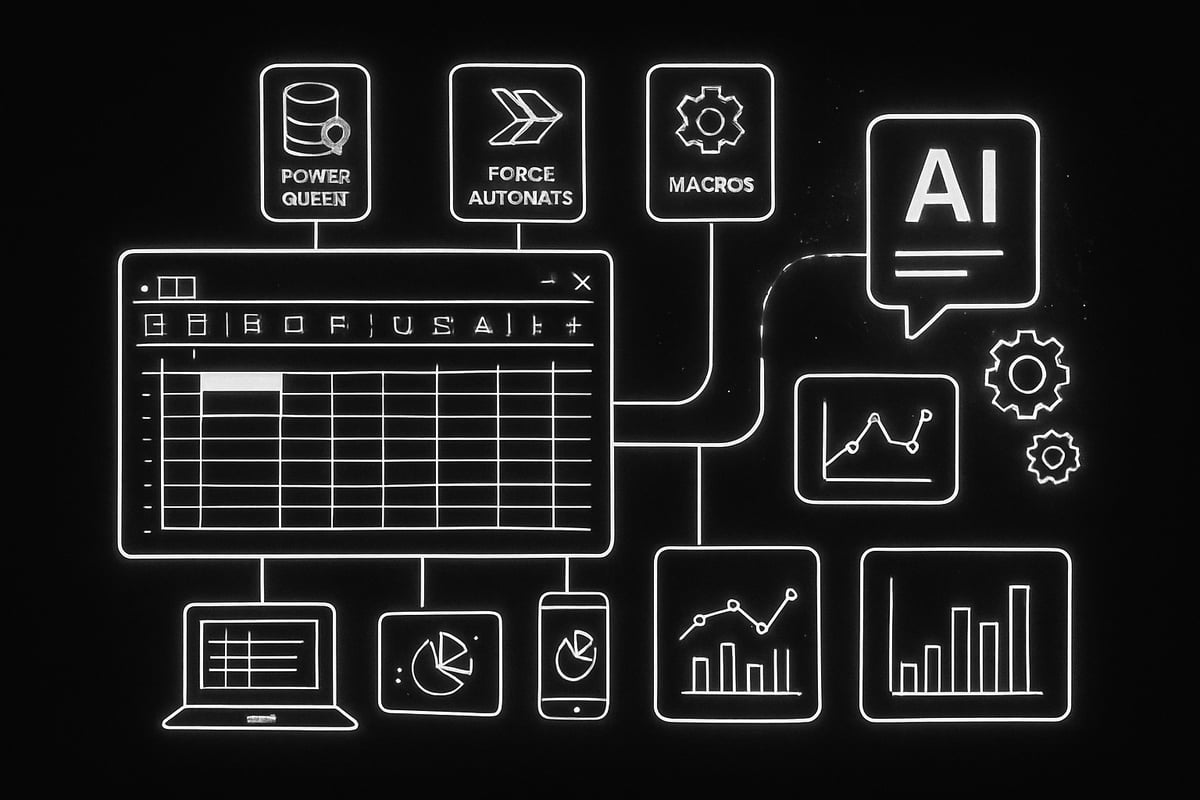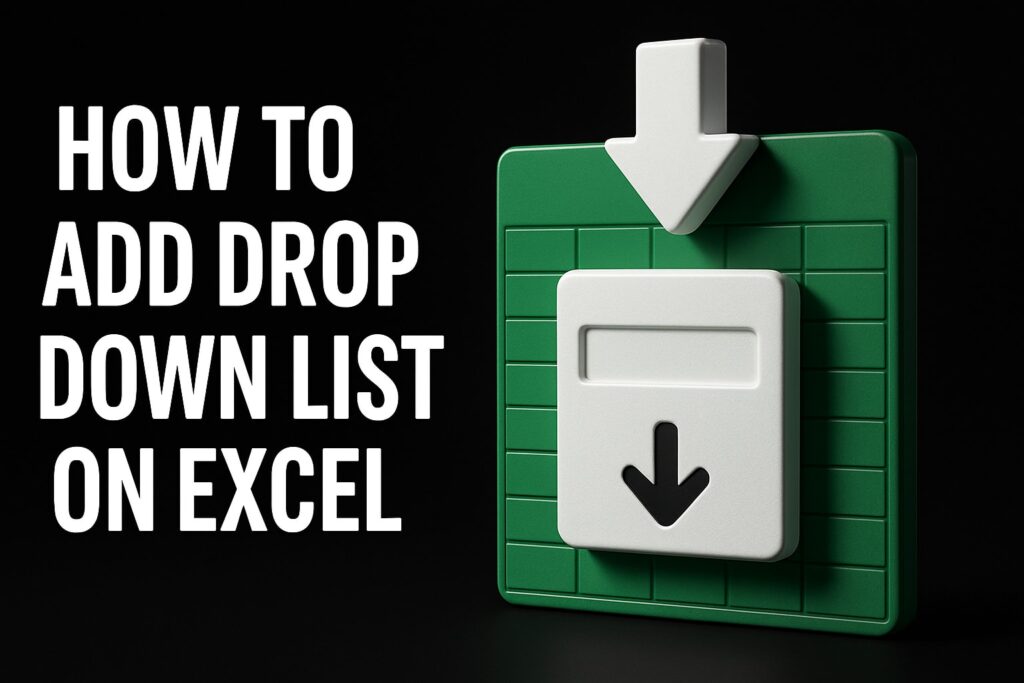In 2025, keeping your business data accurate and efficient depends on how well you update spreadsheet excel files. Outdated formulas, broken links, and missed insights from old data can slow teams down and introduce costly errors. When you master how to update spreadsheet excel workbooks, you can streamline your workflow, cut down on mistakes, and tap into the most advanced Excel features yet. This guide gives you a clear, step-by-step process for using new Excel 2025 tools, automation, and best practices. You’ll discover the latest features, learn how to automate updates, collaborate smarter, and troubleshoot like a pro.
What’s New in Excel 2025: Features Impacting Spreadsheet Updates
Keeping up with new Excel features is crucial if you want to efficiently update spreadsheet excel files in 2025. Whether you manage business budgets or track sales data, understanding these updates will help you unlock more value from every spreadsheet.
Enhanced Data Types and Smart Templates
Excel 2025 introduces powerful data types like dynamic arrays, geography, and stock, making it easier to update spreadsheet excel models with live, structured information. This means your financial models, for example, can automatically pull in up-to-date figures without manual entry.
Smart templates are another leap forward. These templates automate routine updates and keep formatting consistent across your files. For instance, dynamic arrays can now drive auto-updating dashboards, reducing manual intervention and errors. According to a Microsoft Tech Community survey, over 60% of businesses adopt new Excel features in the first year.
To make the most of these new templates, check out Excel Templates for Reports for ideas and best practices.
Real-Time Collaboration and Cloud Integration
With Excel’s enhanced real-time collaboration tools in Microsoft 365, teams can now update spreadsheet excel files together, seeing each other's changes instantly. This eliminates version confusion and speeds up decision-making.
Cloud integration ensures that updates happen seamlessly, no matter where your team is located. Imagine multiple users editing a shared sales report at the same time and all data staying perfectly in sync.
Improved Automation and AI-Powered Suggestions
Excel 2025’s AI-driven features take the guesswork out of updates. When you update spreadsheet excel documents, AI now suggests formulas, flags errors, and even offers corrections on the fly.
Tools like Power Query and Power Automate make it simple to import and refresh data from various sources. For example, you can automatically pull in sales data from your CRM, saving hours of manual updates each week.
Enhanced Data Security and Compliance Tools
Updating spreadsheets securely is more important than ever. Excel 2025 brings advanced permissions, detailed version history, and compliance tracking, which are vital for regulated industries like finance and healthcare.
Now, when you update spreadsheet excel files, you can control who edits, see a clear record of changes, and ensure compliance with company policies.
Compatibility and Cross-Platform Updates
Excel 2025 ensures your updates work everywhere. Whether you’re on Mac, Windows, or using Excel in a web browser, the latest compatibility updates mean you can update spreadsheet excel files without worrying about formatting or feature loss.
Cross-platform support is now smoother, letting you and your team collaborate and update files seamlessly across all your devices.
Step-by-Step Guide: How to Update an Excel Spreadsheet in 2025
Updating your Excel spreadsheets in 2025 is more than just a routine task. It’s a systematic process that, when done right, helps ensure data accuracy, smoother workflows, and full use of the latest features. Let’s walk through each essential step to update spreadsheet excel efficiently and securely.
Step 1: Back Up Your Spreadsheet Before Updating
Before making any changes, always create a backup. This protects your data and lets you restore previous versions if needed.
- Use OneDrive or SharePoint for automatic cloud backups.
- Save copies with timestamped filenames.
- Turn on Excel’s version history for easy rollbacks.
For example, if a major update goes wrong, you can quickly recover a working version. This first step builds confidence as you update spreadsheet excel.
Step 2: Audit Existing Data and Formulas
Next, review your current data, formulas, and links. Look for outdated references, broken formulas, or deprecated functions.
- Use Excel’s Formula Auditing tools to trace dependents and precedents.
- Search for common errors like #REF! or #VALUE!.
- Remove or update old external links.
If you encounter persistent errors, consult the How to Fix Errors in Excel guide for step-by-step troubleshooting. Addressing these issues early ensures a smooth process as you update spreadsheet excel.
Step 3: Integrate New Data Sources and Refresh Connections
Modern Excel makes it easy to connect to databases, APIs, and cloud platforms. Refreshing these connections ensures your data is always up to date.
- Use Power Query for streamlined data imports.
- Set up connections to cloud CRMs or financial databases.
- Refresh all connections before finalizing updates.
For instance, updating sales data from your CRM can be done with a single click, making it easier to update spreadsheet excel with the latest information.
Step 4: Update Formatting, Charts, and Pivot Tables
Visual consistency matters. Apply new formatting styles, update your charts, and refresh pivot tables to reflect the most recent data.
- Use Excel 2025’s modern themes and styles.
- Refresh all pivot tables after importing data.
- Update dashboard visuals for real-time insights.
Automatically updating visuals as you update spreadsheet excel keeps your reports clear and engaging for stakeholders.
Step 5: Implement Automation for Recurring Updates
Automation saves time on repetitive tasks. Set up macros or use Power Automate to handle routine updates and report generation.
- Record macros for common actions.
- Schedule Power Automate flows for weekly or monthly updates.
- Automate data refreshes and report deliveries.
For example, you can automate a weekly financial report, reducing manual work every time you update spreadsheet excel.
Step 6: Test and Validate Updated Spreadsheet
After making changes, verify everything works as expected. Testing helps catch errors before they impact your team.
- Use Data Validation to restrict incorrect entries.
- Apply Conditional Formatting to highlight anomalies.
- Test formulas and data flows for accuracy.
Highlighting inconsistent entries is crucial when you update spreadsheet excel, preventing future issues.
Step 7: Save, Share, and Collaborate Securely
Finally, save your updated file and share it with your team. Secure collaboration is easier than ever with Microsoft 365.
- Set permissions for sensitive data.
- Use sharing links with access controls.
- Track changes and maintain a clear version history.
This approach ensures that when you update spreadsheet excel, everyone works from the latest, most secure version.
Advanced Automation: Streamlining Spreadsheet Updates
Automation has changed the way you update spreadsheet excel files, making the process faster, more reliable, and far less tedious. In 2025, advanced tools like Power Query, Power Automate, and AI-driven features have made it possible to handle complex updates with minimal manual effort. Let’s explore how you can harness these innovations to keep your spreadsheets accurate and efficient.
Leveraging Power Query for Automated Data Refresh
Power Query is a powerhouse for anyone looking to update spreadsheet excel files automatically. With its user-friendly interface, you can connect to multiple data sources, clean data, and merge tables—all in a few clicks.
For instance, you might set up Power Query to pull sales data from your cloud CRM and inventory numbers from a SQL database. Once configured, refreshing your data is as simple as pressing a button. This means your dashboard or report always shows the latest numbers.
Here’s a quick example using Power Query’s M language:
let
Source = Sql.Database("server", "database"),
SalesData = Source{[Schema="dbo",Item="Sales"]}[Data],
InventoryData = Source{[Schema="dbo",Item="Inventory"]}[Data],
Merged = Table.Join(SalesData, "ProductID", InventoryData, "ProductID")
in
Merged
This script merges sales and inventory data, providing real-time insights for decision-makers.
Using Power Automate to Schedule and Trigger Updates
Power Automate takes your automation to the next level by letting you schedule and trigger updates without manual intervention. Imagine setting up a workflow to update spreadsheet excel files every Monday at 8 a.m., pulling in fresh data, updating charts, and emailing the results to your team.
With Power Automate, you can:
- Schedule automatic data refreshes.
- Send notifications when new data is added.
- Generate and distribute reports on a set timetable.
Businesses using Power Automate report up to a 40% reduction in manual update time. If you want a detailed walkthrough, check out Automate Excel Spreadsheets for step-by-step strategies and best practices.
Macros and VBA: When to Use and How to Maintain
Macros and VBA continue to play a crucial role when you need to update spreadsheet excel files with custom actions. Macros are perfect for automating repetitive tasks, such as monthly reconciliations or formatting reports. VBA scripts offer more flexibility, allowing you to create complex automation tailored to your workflow.
To keep your automations reliable:
- Document your scripts thoroughly.
- Test after major Excel updates.
- Store backup copies of your code.
Office Scripts, a newer option, are especially useful in web-based Excel, offering automation with JavaScript-like syntax. Choose the right tool based on your environment and the complexity of your tasks.
AI-Powered Suggestions and Error Correction
Excel 2025 brings AI to the forefront, providing smart suggestions for formulas, flagging inconsistencies, and even recommending optimization techniques. When you update spreadsheet excel files, AI features can detect potential issues before they cause errors.
For example, if you enter a formula with a typo or missing argument, Excel’s AI will suggest corrections or highlight the problem area. It can also recommend better approaches, such as using dynamic arrays for more efficient calculations.
These AI-driven insights not only speed up the update process but also help prevent common mistakes, ensuring your data remains accurate and actionable.
Limitations and Risks of Automation
While automation can greatly simplify how you update spreadsheet excel files, there are some important caveats. Automated scripts can break after software updates or changes in data source structure. Security is another concern, especially if macros are enabled or if sensitive data is handled by automated flows.
Best practices to mitigate risks include:
- Regularly reviewing and testing automated processes.
- Setting up alerts for failed automations.
- Managing permissions carefully to avoid unauthorized changes.
By staying proactive, you can ensure automation continues to work for you—not against you.
Collaboration and Version Control in Modern Excel
Collaboration and version control are now at the heart of how teams update spreadsheet excel files in 2025. With more advanced tools and seamless integration, Excel enables users to work together, track changes, and protect data like never before.
Real-Time Editing and Co-Authoring
Excel 2025 makes real-time collaboration effortless. Multiple users can update spreadsheet excel files simultaneously, seeing each other's changes as they happen. This speeds up teamwork and reduces version confusion.
With features like co-authoring, users can work together on a shared marketing plan or budget, making edits without overwriting each other. The new Excel's new COPILOT function even suggests improvements live, enhancing collaboration. These tools ensure everyone stays on the same page, boosting productivity.
Managing Permissions and Access Levels
Keeping sensitive data safe is vital when you update spreadsheet excel files in a shared environment. Excel 2025 provides more granular control over who can view or edit specific parts of a file.
Admins can assign user roles, such as viewer, editor, or owner, to protect confidential information. For example, editing rights can be restricted for financial statements, ensuring only authorized personnel make changes. This level of control helps maintain data integrity and compliance across your organization.
Version History and Change Tracking
Mistakes happen, but with Excel's robust version history, you can easily roll back unwanted changes as you update spreadsheet excel documents. Every edit is logged, making it simple to recover data after accidental overwrites.
Change tracking allows users to see who made each update and when. This transparency builds trust and makes auditing straightforward. If a team member deletes a critical formula, you can restore a previous version with just a few clicks, saving time and headaches.
Commenting, Notes, and Communication Tools
Clear communication is essential when you update spreadsheet excel files as a team. Built-in commenting and notes features let users leave feedback, ask questions, or tag colleagues for review.
For example, you can highlight a cell and tag a teammate to approve a change before it goes live. This keeps conversations organized and ensures nothing slips through the cracks. Notes and threaded comments help document decisions and speed up the review process for everyone involved.
Integration with Teams and Other Microsoft 365 Apps
Excel 2025 seamlessly connects with Microsoft Teams and other Microsoft 365 apps, streamlining the update spreadsheet excel workflow. You can share files directly in Teams channels, discuss changes in real time, and get instant notifications about updates.
With the introduction of Microsoft 365 Premium with Copilot AI assistant, collaboration becomes even smarter. Copilot helps automate repetitive tasks, summarizes discussions, and suggests next steps based on your data. This deep integration makes team-based spreadsheet management more efficient than ever.
Troubleshooting and Best Practices for Updating Excel Spreadsheets
Updating Excel spreadsheets can present challenges, but with the right approach, you can keep your data accurate, secure, and efficient. Let’s explore practical solutions and expert tips to help you update spreadsheet excel with confidence in 2025.
Common Update Issues and How to Fix Them
When you update spreadsheet excel, common problems include broken links, #REF! errors, and formula issues. These can disrupt workflows and lead to inaccurate reporting.
Here are quick fixes for frequent update problems:
| Issue | Cause | Solution |
|---|---|---|
| #REF! error | Deleted cells or ranges | Use Formula Auditing to trace and fix links |
| Broken links | Moved/deleted source files | Update or remove outdated links |
| #VALUE! error | Incompatible data types | Check data consistency |
For step-by-step help, check out Fixing Excel Formula Errors. This resource guides you through resolving complex issues to keep your spreadsheet running smoothly.
Ensuring Data Integrity and Accuracy
Data integrity is essential when you update spreadsheet excel. Start with built-in validation tools to prevent mistakes before they happen.
- Use Data Validation to restrict input values.
- Apply Conditional Formatting to highlight errors or duplicates.
- Audit formulas using Trace Dependents and Precedents.
For example, set a rule to block duplicate entries in a list. This helps maintain clean, reliable data every time you update spreadsheet excel.
=COUNTIF($A$2:$A$100, A2)=1
Apply this formula in Data Validation to ensure all entries are unique.
Performance Optimization: Keeping Spreadsheets Fast
Large spreadsheets can slow down after repeated updates. When you update spreadsheet excel, optimize for speed by minimizing volatile formulas and using dynamic arrays.
Tips for faster performance:
- Replace old array formulas with dynamic arrays.
- Limit the use of whole-column references.
- Delete unused worksheets and clear excess formatting.
Refreshing data and recalculating only relevant cells can make a big difference. Regularly review your workbook structure to keep performance high as you update spreadsheet excel.
Security Considerations When Updating Spreadsheets
Security is critical, especially for sensitive business data. As you update spreadsheet excel, protect information with encryption and access controls.
- Encrypt files before sharing.
- Set permissions in Microsoft 365 to control access.
- Use version history to recover from accidental changes.
Always verify user roles and restrict editing to authorized team members. These steps keep your data safe every time you update spreadsheet excel.
Staying Up to Date: Training and Resources for 2025
Excel features evolve, so continuous learning is vital. When you update spreadsheet excel, leverage new tools and best practices.
- Join webinars and online courses focused on Excel 2025.
- Read Microsoft’s official documentation for feature updates.
- Participate in forums to share solutions and tips.
Staying informed ensures you gain the full benefits of the latest Excel innovations. This empowers you to update spreadsheet excel efficiently and accurately, no matter how complex your needs become.







